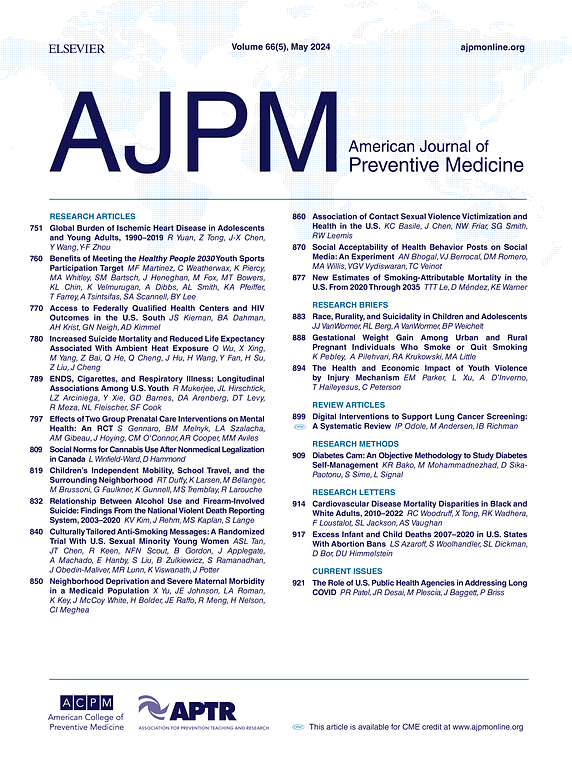Examining Changes in Fatal Violence Against Women After Bail Reform in New Jersey
IF 4.3
2区 医学
Q1 MEDICINE, GENERAL & INTERNAL
引用次数: 0
Abstract
Introduction
Cash bail reforms that end pretrial detention owing to the inability to afford bail have been highly debated across the U.S. A major concern cited by bail reform opponents is that reducing pretrial detention will increase community violence, particularly violence against women. The objective of this study was to assess whether New Jersey's cash bail reform was associated with changes in rates of fatal violence against women.
Methods
This study used synthetic control methods to evaluate the impact of bail reform on the rates of fatal violence against women in New Jersey compared with that in a weighted combination of 21 control states with no bail reform from 2015–2019. Outcome data were from the National Violent Death Reporting System and included intimate partner violence–related homicides, pregnancy-associated homicides, and overall homicides of adult women. Outcomes were measured for all adult women and within racialized groups. Analyses were performed in 2024.
Results
There were no significant changes in the rates of intimate partner violence–related homicide (average treatment effect on the treated= −0.11 deaths per 100,000 women, p=0.1), pregnancy-associated homicide (0.28 deaths per 100,000 births, p=0.8), and overall homicide (−0.03 deaths per 100,000, p=0.1) during the postpolicy period. There were also no significant changes within racialized groups.
Conclusions
Violence against women and mass incarceration are urgent and interconnected public health crises. These findings demonstrate the potential for policies to reduce the number of people incarcerated before trial without increasing fatal violence against women. Addressing these public health crises requires holistic structural interventions, such as housing and economic support, that reduce violence without criminalization.
研究新泽西州保释改革后针对妇女的致命暴力的变化。
现金保释改革结束了由于无力支付保释金而导致的审前拘留,这在美国引起了广泛的争论。保释改革反对者提出的一个主要担忧是,减少审前拘留会增加社区暴力,尤其是针对妇女的暴力。本研究的目的是评估新泽西州的现金保释改革是否与针对妇女的致命暴力率的变化有关。方法本研究采用综合控制方法评估保释改革对新泽西州妇女致命暴力发生率的影响,并与2015-2019年未进行保释改革的21个对照州进行加权组合。结果数据来自国家暴力死亡报告系统,包括与亲密伴侣暴力(IPV)相关的杀人、与怀孕相关的杀人和成年妇女的总体杀人。测量了所有成年女性和种族化群体的结果。分析于2024年进行。结果在政策实施后,与ipvv相关的杀人率(治疗组的平均治疗效果[ATT],每10万名妇女中有-0.11例死亡,p值=0.1)、与妊娠相关的杀人率(每10万名新生儿中有0.28例死亡,p=0.8)和总体杀人率(每10万名新生儿中有-0.03例死亡,p=0.1)没有显著变化。在种族化的群体中也没有明显的变化。暴力侵害妇女行为和大规模监禁是紧迫且相互关联的公共卫生危机。这些发现表明,在不增加针对妇女的致命暴力的情况下,政策有可能减少审前监禁人数。解决这些公共卫生危机需要全面的结构性干预措施,如住房和经济支持,在不定罪的情况下减少暴力。
本文章由计算机程序翻译,如有差异,请以英文原文为准。
求助全文
约1分钟内获得全文
求助全文
来源期刊

American Journal of Preventive Medicine
医学-公共卫生、环境卫生与职业卫生
CiteScore
8.60
自引率
1.80%
发文量
395
审稿时长
32 days
期刊介绍:
The American Journal of Preventive Medicine is the official journal of the American College of Preventive Medicine and the Association for Prevention Teaching and Research. It publishes articles in the areas of prevention research, teaching, practice and policy. Original research is published on interventions aimed at the prevention of chronic and acute disease and the promotion of individual and community health.
Of particular emphasis are papers that address the primary and secondary prevention of important clinical, behavioral and public health issues such as injury and violence, infectious disease, women''s health, smoking, sedentary behaviors and physical activity, nutrition, diabetes, obesity, and substance use disorders. Papers also address educational initiatives aimed at improving the ability of health professionals to provide effective clinical prevention and public health services. Papers on health services research pertinent to prevention and public health are also published. The journal also publishes official policy statements from the two co-sponsoring organizations, review articles, media reviews, and editorials. Finally, the journal periodically publishes supplements and special theme issues devoted to areas of current interest to the prevention community.
 求助内容:
求助内容: 应助结果提醒方式:
应助结果提醒方式:


